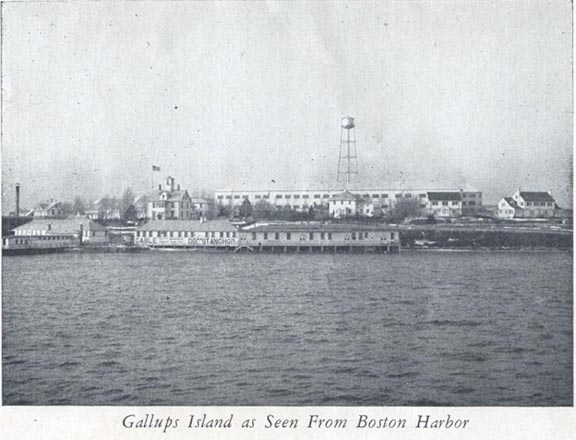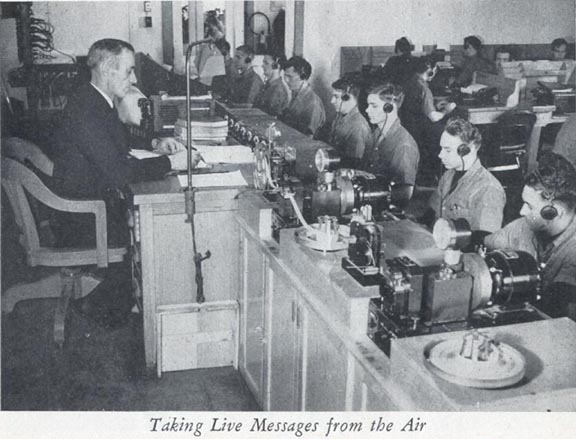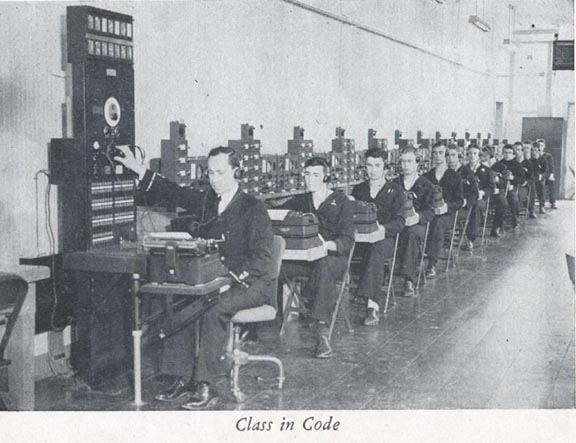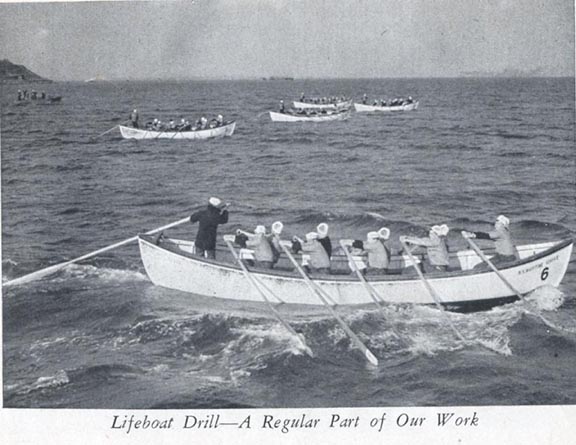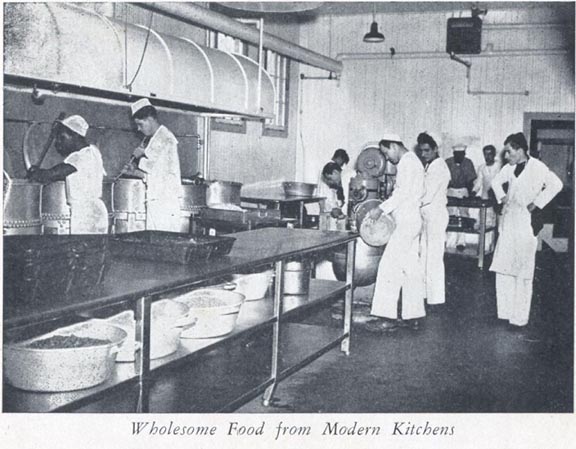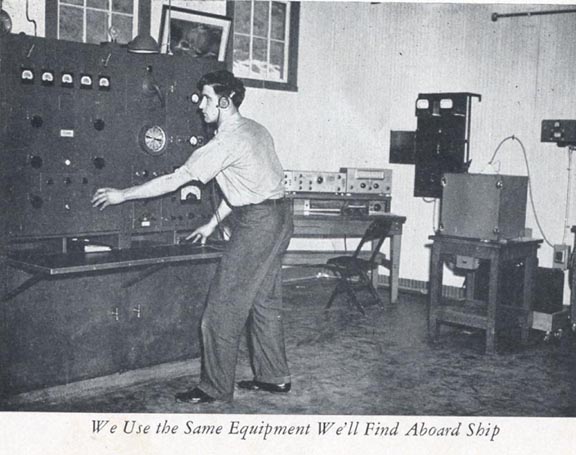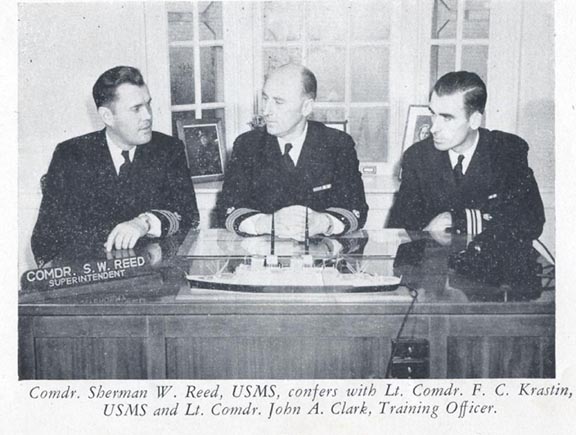Radio Training Station
Gallups Island
Boston, Massachusetts
The Soldier's museum would like to thank our Sponsors whose generous donation of time and resources has made this gallery page possible.
Click on a picture to view the full-sized image
We're going to help "deliver the goods" to our fighting men.
That, in essence, is the reason for our presence at the United States Maritime Service Radio Training School at Gallups Island in Boston Harbor where somewhat more than a thousand of us prospective Merchant Marine Radio Operators are studying and working long hours in an effort to qualify for our second class Radio Telegraph licenses.
As a result of our training here we will soon join those thousands of "unsung heroes" who today are manning the Merchant Fleet that is so successfully carrying food, munitions, clothing and other supplies to our soldiers on all the fighting fronts of the world. Ours will be the privilege of becoming one of that gallant corps of men who, through sheer courage, application of ingenuity and devotion to duty in the face of extreme danger, have been responsible for saving their ships, valuable cargoes and the lives of their shipmates.
As Radio Operators, we will be the voice and hearing of the ship. Upon our ears will fall the first warning signals of danger and upon our shoulders will be placed the responsibility of flashing the first call for help in the event of disaster. In short, the success or failure of a voyage may well depend upon our skill and knowledge.
So important will be our future duties that we are receiving a very practical technical course of training. It includes code, touch typing, operating procedure, radio laws, regulations, international conferences, radio theory, practical laboratory work, operating positions, construction of composite transmitting and receiving equipment, radio-frequency and audio-frequency amplifier systems and related subjects.
Code is, however, one of our more important studies, for once we are assigned to active sea duty we must be able to carryon as efficiently as if we had been constantly engaged in the work for some time and that means taking messages on typewriters as fast as they come over the earphones.
Learning code is a fairly simple task, consuming but a comparatively short time. Building up speed, however, is quite another story, for it takes practice and concentration to acquire the art of copying and sending at rates generally used in commercial work.
Before we came here most of us thought of code only in terms of dots and dashes. The letter A, for example, was dot dash, while the letter D was dash dot dot. One of the first things they taught us when we got here, though, was to forget all about dots and dashes and to think of code in terms of dits and dahs.
Now, the letter A is dit-dah, while the letter D is dah-dit-dit. In the beginning code is shot to us at such a low rate of speed, that letters are easily distinguishable. It is more difficult, however, as trans- mission becomes more rapid, to distinguish between letters. Consequently, more than half of our school day is spent in practicing code.
Each man has his own individual equipment which consists of headphones, speed selector panel, a hand sending key and a typewriter. Code is sent by hand and automatically by code sending machines, which can be regulated to any speed by the instructor.
Before graduating we must be able to copy mixed Code Groups at the rate of 18 words per minute. The ability to do this enables most of us to make plain language copy at the rate of 24 or more words per minute. Before we can get to the point of taking messages on the typewriter we must become fairly efficient at typing. We are learning the touch systems in the best "secretarial" manner and before graduation are able to type at the rate of 35 words per minute which is sufficient for practical operating work.
While code is one of our most important studies here, other subjects of equal or near equal consequence require a great deal of our attention. Take, for instance, radio theory. In order to thoroughly understand how to make necessary repairs we have to know why our equipment functions as it does. Fundamentals of electricity, which many of us studied in high school under the general heading of physics, have to be thoroughly understood. Ohm's law, and others, have to be more than a series of memorized words.
Today's radio equipment is much more complicated than it was during the days of the First World War, with the result that a good portion of our time is spent in the service laboratories learning how to repair receivers, transmitters, direction finding apparatus and other paraphernalia that we may be called upon to service in mid-ocean.
Our service labs, like all other sections of our school, are modern in every respect. Here, we learn how to use tools and undertake the most intricate wiring and soldering jobs. We learn, too, how to trace troubles to their source and become proficient in the use of instruments that aid in the search for defects.
Most interesting to all of us, perhaps, is the actual watch standing that we do. In this phase of our work, we take live messages from the air and learn through experience the routine of shipboard procedure.
Upon completion of our course here we take the usual Federal Communications Commission examinations which are given at the Custom House in Boston. In the first place, requirements for obtaining the coveted second class license are that the applicant must send and receive code at the rate of 16 words per minute mixed code and successfully pass the required elements of the test covering the rules and regulations, basic and advanced radio theory and operating practice.
Strange as it may seem, we complete our work here in somewhat less than half the time required for a like course of study in recognized civilian schools. This is due in great measure to the fact that our curriculum was outlined and prepared by men who are thoroughly familiar with all aspects of radio work. We put in a full six hour day in class, lectures and laboratory work, and facilities are available for an additional three hours at night for those requiring extra study, or wishing to practice.
Then, of course, we have to work hard in order to keep abreast of the schedule that must be maintained. A good deal of outside study is required. Textbooks, especially prepared by members of the faculty, are used in our class work, while standard electrical textbooks and technical magazines are used for reference purposes and may be drawn from the more than 3,000 copies in the school library.
Add to these the fact that all of us who were admitted had to measure up to the educational standards set by the Maritime Service and you begin to see why this intensified course is so successful. Among other things, a high school education that included at least one year of algebra is necessary for admittance to the school. Physics, though not required, is a subject that should have been included in our high school work.
The school, itself, is considered the best of its kind in the world. Not only is its faculty composed of men who are "tops" in their field, but the equipment that is put at our disposal is without a peer. The standard marine radio laboratory boasts at least one of each type of radio equipment now being installed in vessels under construction for the U. S. Maritime Commission. Included are crystal-con- trolled intermediate and high frequency transmitters, tuned radio frequency and superhetrodyne receivers, radio direction-finding equipment, automatic alarm equipment, standby equipment, lifeboat transmitting equipment, small craft radiotelephone equipment, and , accessories. The most recent addition is the new RMCA Model 4U "Marine Unit," incorporating high-frequency and intermediate-frequency transmitting equipment and all-wave receivers, which is being placed aboard many new vessels.
Unlike Topsy, in "Uncle Tom's Cabin"; who "just growed', Gallups Island Radio Station "growed" according to plan - but according to a plan that did not at first look forward to such rapid expansion. Started but a short time ago with a view to training 400 men at a time, it now provides for nearly thrice that number.
Housing facilities are more than adequate. Most of us are quartered in barracks similar to those used by the Army. Buildings of frame construction, used originally by the United States Public Health Service which previously inhabited the Island, have been converted into quarters, classrooms and laboratories. Additional construction was necessary to keep pace with expansion, but several very beautiful homes left by Health Service officials now give the Island the appearance of a better class suburb. Today, they are used as administration offices, sick bay and Officers' Mess Halls.
Commander Sherman W. Reed, U. S. Maritime Service, in command of the station, is a Bostonian with some 25 years' experience at sea. He is a graduate of the Massachusetts Nautical Training School and has sailed the North and South Atlantic in positions ranging from third mate to Master of all types and sizes of vessels. He made 78 round trips as third and second officer aboard the Leviathan, which at that time was the world's largest ship. He is a First Class pilot from Boston to Norfolk and the" Chesapeake Bay, including bays, harbors, rivers, etc. He entered the Maritime Service from sea service in 1942. He is married and the father of one son.
Our Executive Officer, Lieutenant Commander F. C. Krastin, U.S.M.S. has followed the sea since shortly after his graduation from high school when he shipped out as an ordinary seaman. He passed his examination for Third Mate at the age of twenty and was soon sailing in that capacity. Subsequent promotions led to a berth in 1941 as Chief Officer aboard United Fruit Company Ships. He entered the U. S. Maritime Service in the same year. Since then he has raised his license and now holds an unlimited Master's ticket. He has served as navigator and Executive Officer aboard the Training Ships AMERICAN PILOT and AMERICAN NAVIGATOR. He was assigned to Gallups Island in April of 1944.
Of course, all of our recreational activities are planned for us by a chief specialist whose duty it is to organize the many amateur shows that are presented here and to make arrangements for us to attend the parties and dances that are sponsored occasionally by the many patriotic societies in and about Boston.
As on any other base, we have our own ship's store where we can purchase many of the articles that you buy at the corner store. Such items as shoe laces, candy, cigarettes, stationery, some types of clothing, periodicals and many other items are always in stock. A barber shop, laundry service, and tailor go to make our little community complete.
Candidates for training at Gallups Island are selected from men who have completed preliminary training in seamanship at Sheepshead Bay U.S.M.S. Training Station.
At the conclusion of the war we'll be members of a Merchant Marine that will be the queen of the seas - members who will enjoy the privileges and pay of specialists aboard ship.
Become a Contributing Sponsor to the Soldier's
Museum

